|
Clematis seed can be found
in all shapes and sizes and as a quick guide to help you
understand what is good seed and what is not then please
read on.
Generally clematis seeds are made up of what is the seed
or to give it its proper name an achene connected to which
is usually (but not always) a long plumose (feathery) tail. The
seed pod itself can be a few mm to over 10mm across, but
how do you know what is and is not good seed.
Lets take a look at the sequence of photographs starting
with the basics:-
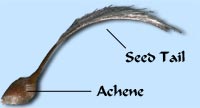 The
seed itself is made up of the seed pod or achene and
usually a feathery tail. Note the seed on this example
has a brown seed pod which indicates it is ripe and ready
for sowing. The
seed itself is made up of the seed pod or achene and
usually a feathery tail. Note the seed on this example
has a brown seed pod which indicates it is ripe and ready
for sowing.
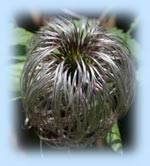
Seed heads of some clematis are quite easy to spot as they
take on a somewhat spidery appearance (especially those
with long
 tails).
The tails on the first example are still quite sleek and
shiny which tells us the seeds are not yet ripe. tails).
The tails on the first example are still quite sleek and
shiny which tells us the seeds are not yet ripe.
This can easily
be shown by snipping off the tails and the green seeds
are then exposed.
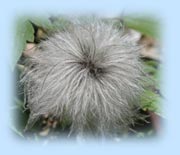 Seed
heads bearing ripe seed are generally very fluffy in appearance
and by just touching the seed head the brownish seeds will
easily break away. Seed
heads bearing ripe seed are generally very fluffy in appearance
and by just touching the seed head the brownish seeds will
easily break away.
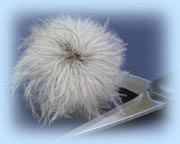 If
you wish to send seed to the seed exchange or even if you
wish
to grow it yourself the seed tails
are not If
you wish to send seed to the seed exchange or even if you
wish
to grow it yourself the seed tails
are not  necessary
for sowing necessary
for sowing
and can be carefully cut away using a pair of sharp
scissors. The seed can then be cleaned of dirt and dust.
These actions will also aid sorting at the other end and
also stop those creepy crawlies getting packaged in with
the seed (it is accepted that on some of the smaller seed
this is not always practical).
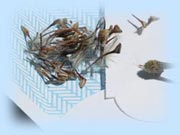 If
you wish to store the seed or send it off to the seed exchange
you should gently detach the ripened brown seed, clean
them off and place them in a dry envelope which should
then be sealed. If
you wish to store the seed or send it off to the seed exchange
you should gently detach the ripened brown seed, clean
them off and place them in a dry envelope which should
then be sealed.  Most
importantly of all the name and date the seed was collected
should be written on the envelope. If your ripened seed
is damp you should let it dry out in an airy position before
cleaning them and placing in the envelope. Seed which has
only partially ripened (still slightly green) is still
viable as it can be left to ripen again in an airy position
before placing in an envelope. Most
importantly of all the name and date the seed was collected
should be written on the envelope. If your ripened seed
is damp you should let it dry out in an airy position before
cleaning them and placing in the envelope. Seed which has
only partially ripened (still slightly green) is still
viable as it can be left to ripen again in an airy position
before placing in an envelope.
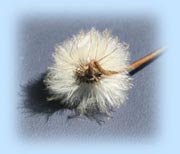 As
an additional aid here follows pictures of what is infertile seed
(i.e. that which has not been fertilised and does not bear
seed). You can see from the picture on the right that the
seed tails although being quite fluffy are very short and
stubby. If you touch the tails they break away quite easily
and bear no seed although it is sometimes falsely assumed
that the small black area which was once the ovary is viable
seed As
an additional aid here follows pictures of what is infertile seed
(i.e. that which has not been fertilised and does not bear
seed). You can see from the picture on the right that the
seed tails although being quite fluffy are very short and
stubby. If you touch the tails they break away quite easily
and bear no seed although it is sometimes falsely assumed
that the small black area which was once the ovary is viable
seed  but
unfortunately it is not. As a contrast look at this last
picture which shows a half fertilised seed head, the fertilised
seeds are easily distinguishable by the much longer silky
seed tails attached to the as yet un ripened seed. The
infertile seed tails are much shorter and have already
become quite fluffy. but
unfortunately it is not. As a contrast look at this last
picture which shows a half fertilised seed head, the fertilised
seeds are easily distinguishable by the much longer silky
seed tails attached to the as yet un ripened seed. The
infertile seed tails are much shorter and have already
become quite fluffy.
|









